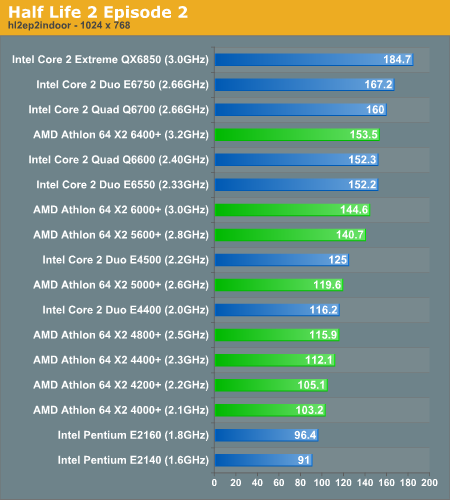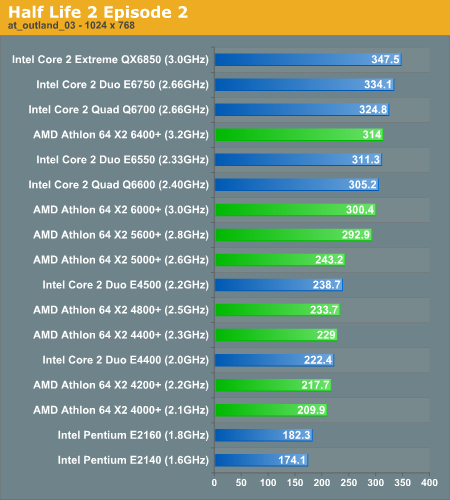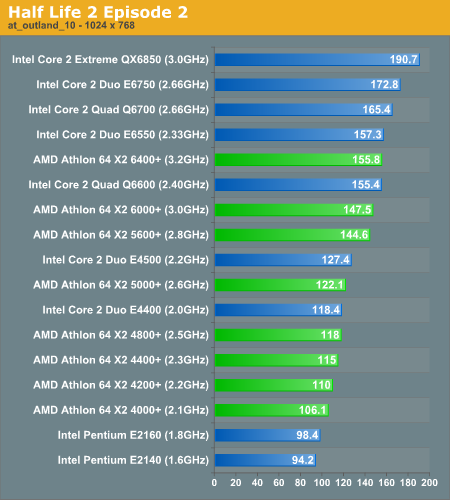UPDATED Half-Life 2: Episode 2 CPU and Graphics Performance
by Anand Lal Shimpi & Derek Wilson on October 12, 2007 7:00 AM EST- Posted in
- GPUs
The Benchmarks
We ran all of our tests on the following system configurations:
We'll start off with a look at CPU performance. For these tests we ran at 1024 x 768 to minimize any GPU bottlenecks and highlight differences between CPUs.
CPU Performance
Our first benchmark is of an indoor map with a reasonable sized firefight taking place. The frame rates are high due to the indoor environment but the explosions and computer interaction keep our CPUs busy doing more than just feeding data to the GPU.

Intel continues to hold onto the overall performance crown as AMD has nothing faster than the Athlon 64 X2 6400+, but the race is a bit closer at lower price points.
The limited production 6400+, albeit more expensive than Intel's Core 2 Duo E6750, ends up underperforming its closest competitor. The Core 2 Duo E6550 is about 5% faster than the Athlon 64 X2 6000+, but honestly the performance advantage isn't large enough to really matter, especially in more realistic GPU-bound scenarios.
The Core 2 Duo E4000 series ends up losing a bit of ground to AMD thanks to having a smaller L2 cache and slower FSB, both of which Episode 2 is particularly sensitive to. The Athlon 64 X2 5600+ is 12% faster than its price-competitor, the Core 2 Duo E4500. It's interesting to note the impact of L2 cache size on performance even in the AMD camp; the Athlon 64 X2 5000+ only has a 512KB L2 per core (vs. 1MB of the 5600+) and performance drops significantly, to the point where it's a toss up between the 5000+ and the Core 2 E4400.
At the low end of the spectrum, Half Life 2's dependency on very fast memory accesses and large cache sizes really penalize the Pentium Dual-Core processors, both of which are bested by their AMD rivals. AMD's margin of victory isn't tremendous but it's clear that Intel's lack of an on-die memory controller does hinder gaming performance of these small-cache parts.
Look at real world performance however, even the difference between an Athlon 64 X2 4200+ and a Pentium E2160 will be largely masked by GPU limitations at higher resolutions.
Our next benchmark takes place in the outland_03 level, in a small indoor environment resulting in ridiculously high frame rates for all of the CPUs. The performance comparison in this benchmark is almost purely academic, simply highlighting differences between microprocessors as even the cheapest CPUs in this comparison pull over 170 fps in this test.

Half Life 2 Episode 2 continues to be very sensitive to FSB frequency, which is part of the reason why we see the dual core E6750 (1333MHz FSB) pull ahead of the quad core Q6700 (1066MHz FSB). There's slight overhead associated with running HL2 on a quad-core system, which doesn't make for a better situation, not to mention that the game doesn't take advantage of more than two threads. Quad-core owners won't really be plagued by lower performance than their dual core compatriots, but they simply don't get any benefit out of the latest version of Valve's Source engine. The standings remain relatively unchanged, once more we see that L2 cache size and latency strongly impact performance. The 90nm Athlon 64 X2 5600+ features a 1MB L2 cache per core with a slightly lower access latency than the 65nm Athlon 65 X2 5000+, with its 512KB L2 per core, the resulting performance difference is significant; the 5600+ holds onto a 20% performance advantage over the 5000+, despite only a 7.6% increase in clock speed.
Intel's Core 2 lineup gets hurt even worse as you look at the 800MHz FSB/2MB L2 E4000 parts. The E4500 is seriously outperformed by the 5600+ and ends up being equal to the 5000+, despite the latter being priced lower.
The Pentium Dual-Core processors pull up the rear once more, thanks to even lower clock speeds and meager 1MB L2 caches shared between two cores.
Our final performance test takes place in the outland_10 map, an outdoor environment where we spend most of our time driving around (poorly) and avoiding the topography of the level.

The standings remain unchanged: Intel holds the overall performance crown, the two are competitive at $150 - $200 price points, and AMD manages to pull ahead in the sub $150 market.
We ran all of our tests on the following system configurations:
| Test Setup | |
| CPU | Core 2 Duo E6550 (2.33GHz 4MB 1333FSB) Core 2 Duo E4500 (2.2GHz 2MB 800FSB) Core 2 Duo E4400 (2.0GHz 2MB 800FSB) Pentium E2160 (1.8GHz 1MB 800FSB) Pentium E2140 (1.6GHz 1MB 800FSB) AMD Athlon X2 5000+ (2.6GHz 2x512K) AMD Athlon X2 4800+ (2.5GHz 2x512K) AMD Athlon X2 4200+ (2.2GHz 2x512K) AMD Athlon X2 4000+ (2.1GHz 2x512K) |
| Motherboard | Intel: ASUS P5K-V G33 AMD: Biostar TF-7050M2 |
| Video Cards | AMD Radeon HD 2900 XT AMD Radeon HD 2600 XT AMD Radeon HD 2600 Pro AMD Radeon HD 2400 XT NVIDIA GeForce 8800 Ultra NVIDIA GeForce 8800 GTX NVIDIA GeForce 8800 GTS 320MB NVIDIA GeForce 8600 GTS NVIDIA GeForce 8600 GT |
| Video Drivers | AMD: Catalyst 7.10 NVIDIA: 163.69 |
| Hard Drive | Seagate 7200.9 300GB 8MB 7200RPM |
| RAM | 2x1GB Corsair XMS2 PC2-6400 4-4-4-12 |
| Operating System | Windows Vista Ultimate 32-bit |
We'll start off with a look at CPU performance. For these tests we ran at 1024 x 768 to minimize any GPU bottlenecks and highlight differences between CPUs.
CPU Performance
Our first benchmark is of an indoor map with a reasonable sized firefight taking place. The frame rates are high due to the indoor environment but the explosions and computer interaction keep our CPUs busy doing more than just feeding data to the GPU.

Intel continues to hold onto the overall performance crown as AMD has nothing faster than the Athlon 64 X2 6400+, but the race is a bit closer at lower price points.
The limited production 6400+, albeit more expensive than Intel's Core 2 Duo E6750, ends up underperforming its closest competitor. The Core 2 Duo E6550 is about 5% faster than the Athlon 64 X2 6000+, but honestly the performance advantage isn't large enough to really matter, especially in more realistic GPU-bound scenarios.
The Core 2 Duo E4000 series ends up losing a bit of ground to AMD thanks to having a smaller L2 cache and slower FSB, both of which Episode 2 is particularly sensitive to. The Athlon 64 X2 5600+ is 12% faster than its price-competitor, the Core 2 Duo E4500. It's interesting to note the impact of L2 cache size on performance even in the AMD camp; the Athlon 64 X2 5000+ only has a 512KB L2 per core (vs. 1MB of the 5600+) and performance drops significantly, to the point where it's a toss up between the 5000+ and the Core 2 E4400.
At the low end of the spectrum, Half Life 2's dependency on very fast memory accesses and large cache sizes really penalize the Pentium Dual-Core processors, both of which are bested by their AMD rivals. AMD's margin of victory isn't tremendous but it's clear that Intel's lack of an on-die memory controller does hinder gaming performance of these small-cache parts.
Look at real world performance however, even the difference between an Athlon 64 X2 4200+ and a Pentium E2160 will be largely masked by GPU limitations at higher resolutions.
Our next benchmark takes place in the outland_03 level, in a small indoor environment resulting in ridiculously high frame rates for all of the CPUs. The performance comparison in this benchmark is almost purely academic, simply highlighting differences between microprocessors as even the cheapest CPUs in this comparison pull over 170 fps in this test.

Half Life 2 Episode 2 continues to be very sensitive to FSB frequency, which is part of the reason why we see the dual core E6750 (1333MHz FSB) pull ahead of the quad core Q6700 (1066MHz FSB). There's slight overhead associated with running HL2 on a quad-core system, which doesn't make for a better situation, not to mention that the game doesn't take advantage of more than two threads. Quad-core owners won't really be plagued by lower performance than their dual core compatriots, but they simply don't get any benefit out of the latest version of Valve's Source engine. The standings remain relatively unchanged, once more we see that L2 cache size and latency strongly impact performance. The 90nm Athlon 64 X2 5600+ features a 1MB L2 cache per core with a slightly lower access latency than the 65nm Athlon 65 X2 5000+, with its 512KB L2 per core, the resulting performance difference is significant; the 5600+ holds onto a 20% performance advantage over the 5000+, despite only a 7.6% increase in clock speed.
Intel's Core 2 lineup gets hurt even worse as you look at the 800MHz FSB/2MB L2 E4000 parts. The E4500 is seriously outperformed by the 5600+ and ends up being equal to the 5000+, despite the latter being priced lower.
The Pentium Dual-Core processors pull up the rear once more, thanks to even lower clock speeds and meager 1MB L2 caches shared between two cores.
Our final performance test takes place in the outland_10 map, an outdoor environment where we spend most of our time driving around (poorly) and avoiding the topography of the level.

The standings remain unchanged: Intel holds the overall performance crown, the two are competitive at $150 - $200 price points, and AMD manages to pull ahead in the sub $150 market.










46 Comments
View All Comments
tonrav - Monday, December 3, 2007 - link
ERROR: demo network protocol 11 outdated, engine version if 14.Google reveals little of what this means except that Valve possibly rev'd something in EP2 without putting backwards compatibility in the code. Anybody know a way to play these demo's or convert them?
NullSubroutine - Thursday, October 18, 2007 - link
Did you use Super Sampling or Multi-Sampling on ATI cards?Powered by AMD - Tuesday, October 16, 2007 - link
i downloaded the dem files, but where do i have to put them and what do i have to type in the console to get it working?thanks in advance.
Zaitsev - Tuesday, October 16, 2007 - link
Thanks for taking the time to bench some older cards. It's crazy that a x1900xtx = hd 2900xt with antialiasing on. o.0zero2dash - Monday, October 15, 2007 - link
FSB O/C that E2160 to 3 gig on air and then benchmark it.Who runs the E21x0's at stock? Seriously??
I know you're trying to equal things across the board, but at least throw in an O/C number in there *somewhere*.
-Just a thought.- =)
Radeon 1950 FTW
Looks like the best card below the 8800GTS line especially at the $150 price point...nice.
NARC4457 - Monday, October 15, 2007 - link
I'm just sad that my GPU/CPU are even older than this list. That said, Ep2 is running great at 1280x1040 with most settings at medium and 2xAA.
bojaka - Monday, October 15, 2007 - link
First of I have no idea how much shortcuts they have taken when trying to get Motionblur and good shadows to work since they are both awful!The motionblur is just strange and the shadows looks good, but they don't seem to be calcylated correctly from the flashlight. Try standing in front of something with your flashlight turned on so the shadow falls on a wall in front of you and turn from left to right and you should see the shadow move in a very unrealistic manner.
How ever... It's a beautiful and fun to play game that really shouls have been benchmarked indoors and outdoors with full shadows and the flashlight turned on. Then you should have seen some different framrates! =( So disappointed at the performance (1280x1024 4xAA, 8xAniso end everything on highest on my C2D E6600 (800Mhz FSB), 2GB RAM, 8800GTS 640MB)
New benchmarks wanted!!! Flashlight on and shadows on!!!
DerekWilson - Tuesday, October 16, 2007 - link
all the graphics options were turned all the way up -- shadows were on. I played with the flash light but didn't see any significant difference in framerate.tonjohn - Tuesday, October 16, 2007 - link
Derek,You need to fix the part of the article that says that the new build of the Source engine only supports two threads. Mike Durand of Valve has confirmed that the latest build of the Source engine defaults to three threads for EP2 and Portal and two threads for TF2.
jeffrey - Sunday, October 14, 2007 - link
The article states that the GPU wasn't the limiting factor and that's fine, however I would still like to know what card/driver was used in the CPU test rig.